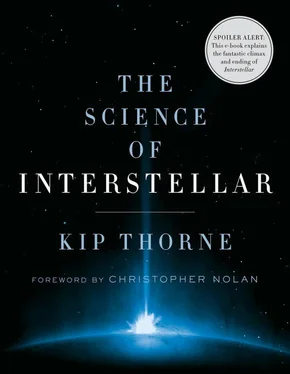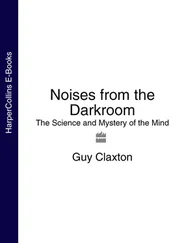A person at rest far from the hole experiences an oscillating stretch then squeeze then stretch as the tendex lines travel outward through her. The tendex lines have become a gravitational wave. Wherever the lines in the plane of the picture are strongly blue (strongly squeezing), there are strongly red lines coming out of the picture, that stretch. And wherever the lines in the picture are strongly red (stretching), there are blue (squeezing) lines pointing in the third direction, out of the picture. As the waves flow outward, the hole’s deformation gradually grows weaker and the waves weaken.
When these waves reach Earth, they have the form that I show in the upper part of Figure 16.8. They stretch along one direction and squeeze along the other. The stretch and squeeze oscillate (from red right-left to blue right-left to red right-left, etc.) as the waves pass through the detector in the bottom part of Figure 16.8.
The detector consists of four huge mirrors (40 kilograms, 34 centimeters in diameter) that hang from overhead supports at the ends of two perpendicular arms. The waves’ tendex lines stretch one arm while squeezing the other, and then squeeze the first while stretching the second, over and over and over again. The oscillating separation between mirrors is monitored with laser beams, by a technique called interferometry. Hence LIGO’s name: Laser Interferometer Gravitational Wave Observatory.
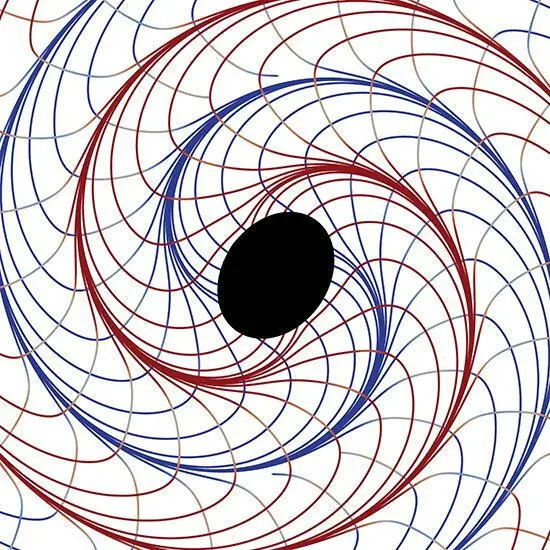
Fig. 16.7. Tendex lines from a spinning, deformed black hole. [Drawing by Rob Owen.]
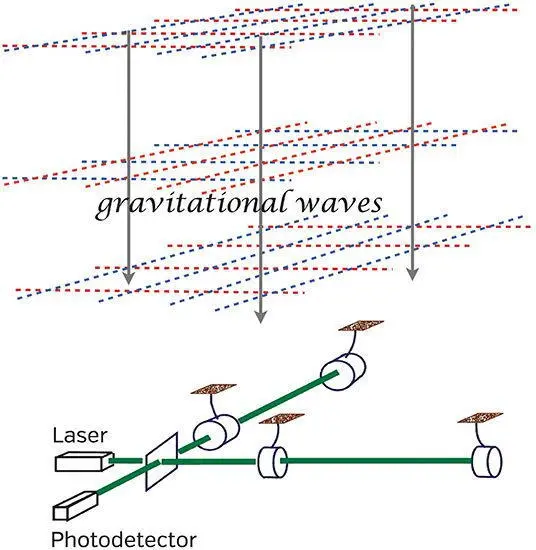
Fig. 16.8. Gravitational waves impinging on a LIGO detector.
LIGO is now an international collaboration of 900 scientists in seventeen nations, headquartered at Caltech. It is currently led by David Reitze (director), Albert Lazzarini (deputy director) and Gabriella Gonzalez (spokesperson for the collaboration). And in view of its huge potential payoffs for our understanding of the universe, it is funded primarily by US taxpayers, through the National Science Foundation.
LIGO has gravitational wave detectors in Hanford, Washington, and Livingston, Louisiana, and is planning to place a third in India. Scientists in Italy, France, and the Netherlands have built a similar interferometer near Pisa, and Japanese physicists are building one in a tunnel under a mountain. These detectors will all operate together, forming a giant worldwide network to explore the universe using gravitational waves.
Having trained many scientists who work on LIGO, in 2000 I turned my own research in other directions. But I watch eagerly as LIGO and its international partners near maturity and near their first detections of gravitational waves.
The Warped Side of the Universe
Interstellar is an adventure in which humans encounter black holes, wormholes, singularities, gravitational anomalies, and higher dimensions. All these phenomena are “made from” warped space and time, or are tied intimately to that warping. This is why I like to call them the “warped side of the universe.”
We humans, as yet, have very little experimental or observational data from the universe’s warped side. That’s why gravitational waves are important: they are made from warped space, and so they are the ideal tool for probing the warped side.
Suppose you had only seen the ocean on a very calm day. You would know nothing of the heaving seas and breaking ocean waves that come with a huge storm.
That is similar to our knowledge, today, of warped space and time. We know little about how warped space and warped time behave in a “storm”—when the shape of space is oscillating wildly and the rate of flow of time is oscillating wildly. For me this is a fascinating frontier of knowledge. John Wheeler, the creative coiner we met in earlier chapters, dubbed this “geometrodynamics”: the wildly dynamical behavior of the geometry of space and time.
In the early 1960s, when I was Wheeler’s student, he exhorted me and others to explore geometrodynamics in our research. We tried, and failed miserably. We didn’t know how to solve Einstein’s equations well enough to learn their predictions, and we had no way to observe geometrodynamics in the astronomical universe.
I’ve devoted much of my career to changing this. I cofounded LIGO with the goal of observing geometrodynamics in the distant universe. In 2000, when I turned my LIGO roles over to others, I cofounded a research group at Caltech aimed at simulating geometrodynamics on supercomputers, by solving Einstein’s relativistic equations numerically. We call this project SXS: Simulating eXtreme Spacetimes. It is a collaboration with Saul Teukolsky’s research group at Cornell University, and others.
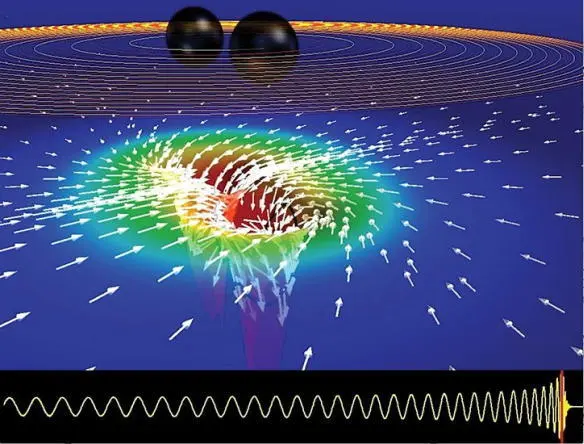
Fig. 16.9. Simulation of two black holes at their moment of collision. Top : The holes’ orbits and shadows as seen in our universe. Middle : The holes’ warped space and time as seen from the bulk, with arrows showing the dragging of space into motion and colors the warping of time. Bottom : The emitted gravitational waveform. This simulation is for identical, nonspinning black holes. [From a movie by Harald Pfeifer of a simulation by the SXS team.]
A wonderful venue for geometrodynamics is the collision of two black holes. When they collide, the holes set space and time into wild gyrations. Our SXS simulations have now reached maturity, and are beginning to reveal relativity’s predictions (Figure 16.9). LIGO and its partners will observe the gravitational waves from colliding black holes within the next few years, and test our simulations’ predictions. It’s a wonderful era for probing geometrodynamics!
Gravitational Waves from the Big Bang
In 1975 Leonid Grishchuk, a dear Russian friend of mine, made a startling prediction: A rich plethora of gravitational waves was produced in the big bang, he predicted, by a previously unknown mechanism: Quantum fluctuations of gravity coming off the big bang were amplified enormously, he told us, by the universe’s initial expansion; and when amplified, they became primordial gravitational waves. If discovered, these gravitational waves could bring us a glimpse of our universe’s birth.
In subsequent years, as our understanding of the big bang matured, it became evident that the waves would be strongest at wavelengths nearly as large as the visible universe itself, billions of light-years’ wavelength, and would likely be too weak for detection at LIGO’s far shorter wavelengths, hundreds and thousands of kilometers.
In the early 1990s several cosmologists realized that these billion-light-years-long gravitational waves should have placed a unique imprint on electromagnetic waves that fill the universe, the so-called cosmic microwave background or CMB. A holy grail quickly emerged: search for that CMB imprint, from it infer the properties of the primordial gravitational waves that produced the imprint, and thereby explore the birth of the universe.
In March 2014, while I was writing this book, the CMB imprint was discovered by a team assembled by Jamie Bock (Figure 16.10), [30] The formal leaders of the discovery team were Jamie and his former postdoctoral students John Kovac (now at Harvard) and Chao-Lin Kuo (now at Stanford), along with Clem Pryke (now at the University of Minnesota).
a cosmologist down the hall from me at Caltech.
Читать дальше
